At first glance, it would be easy to compare Insomnia: The Ark to games like Fallout 4 and even Bioshock.
Its diesel-punk inspired retro future screams both Bethesda and Ken Levine from the moment you hit “new game”. However, Insomnia: The Ark quickly morphs into something of a genre hybrid.
In some ways, it’s an action-adventure with deep RPG elements, intricate story lines, and an expansive, sprawling world. In others, it’s a horror game dabbling in the existential torment of life, death, and the purgatory in between.
In these ways, Insomnia: The Ark is as engrossing as it is interesting. It’s a game that seeks to find a unique balance between action and repose, fetch quests and the theology of the soul.
Despite its compelling nature, the game has its share of issues. Some of these are easily overlooked (and are set to be patched in a day-one update), while others are seemingly endemic to its development. From bugs and glitches to an overly complex story and a few strange design choices, Insomnia has a habit of getting in its own way.
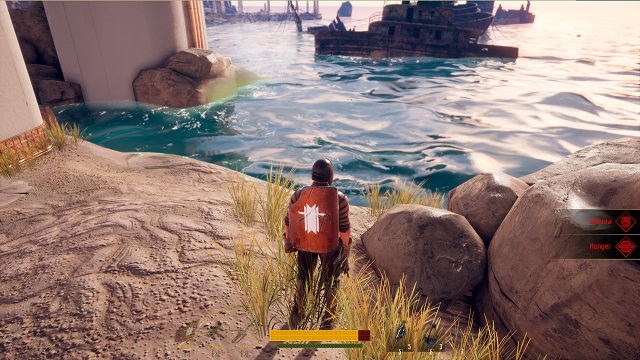
Story
Although I’m only around 12 hours into the game’s expansive narrative, I can easily say that the story is deep and labyrinthine. Tackling topics such as life and death, authoritarianism, and the politics of xenophobia, Insomnia crafts a sprawling mosaic of complicated moving parts.
It’s not exactly clear who you’re playing as in the game’s early stages — a slum-dog gopher named Thyper or a dutiful soldier that (luckily) escaped a horrific blast in the State’s cryogenic sleeping bay.
What is known for certain is that the world you’re thrust into is one full of violence, suppression, and mystery. As the mammoth metropolis of Object 6 hurtles through space to find a new home for the humans inhabiting it, a rebellion brews in its sewers and back alleys.
Everywhere you see signs of The Committee, the authoritarian regime ruling Object 6 with nothing less than an iron fist. But you also see something more, something beyond the physical suffering and turmoil around you. There’s an ether that beckons you away from “the surface”.
Beginning as an illness that appears to cause psychosis, depression, and delusion, you soon begin to understand that Somnia is more than another word for schizophrenia. Somnic lapses, as they’re referred to, begin to illuminate the true nature of your character.
The only sticking point is that this multilayered narrative can easily get convoluted, especially when the dialogue and writing becomes overly complex. It’s by no means Tolkien-esque in nature, but following the game’s narrative threads can sometimes turn into work, leaving you more perplexed than informed in the game’s early running.
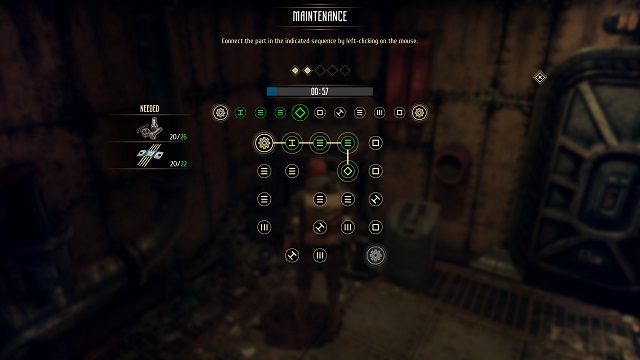
Gameplay
The most important thing you need to know about Insomnia is that in the first 10 to 12 hours, there’s a lot of exploration — with a little bit of combat and puzzle solving sprinkled in between.
Most of your time will be spent traveling from one side of Object 6 to the other, learning about the world, investigating shadow collectives, and helping quest givers deliver old-world record players. If you’re into the story and diesel-punk aesthetic, it’s more interesting than it sounds — but it can get a bit tedious walking from one area to another and back again.
Each area in Insomnia‘s semi-open world is large and often multi-tiered. You’re able to travel from hub to hub using each area’s exit points before selecting a destination on an overworld map. Think Pillars of Eternity in this regard.
Along the way, there will often be random encounters with traveling shop keeps or helpless friendlies looking for a hand. Others will be with highwaymen and gangs, many of which you’ll need to quickly dispatch, loot, and leave behind.
For much of the early game, it feels like Insomnia‘s combat is centered around these types of encounters, supplemented by a few story arcs that put the cross hairs between you and a few pesky mercenaries (or riotous citizens, whatever the case may be).
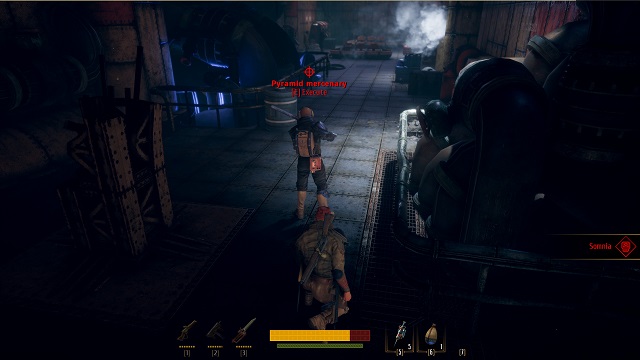
Combat is real-time. And it can be utterly unforgiving.
You’re able to choose from a variety of weapons, such as long rifles, sub-machine guns, swords, mallets, and even your fists. Depending on what class you choose after the game’s prologue, you’ll also be more proficient in certain areas than others (although in the current build, it doesn’t seem like one class has an exponential advantage over another).
However, strategy does have a distinct advantage over chaos, as a guns-blazing approach will often get you promptly eviscerated. Insomnia‘s combat requires a tactical, discerning eye; strategizing your movements before you make them and keeping your eye on your stamina meter will keep you from loading checkpoints over and over again.
Stealth kills are almost always a necessity to even the odds. Strafing and rolling are important if you’re killing from long-range without cover, while sprinting and dodging are important if you’re bull-rushing with a sword or melee weapon. And most importantly, taking cover is an absolute must against a contingent with guns.
While this sounds relatively deep, the primary reason combat is so predicated on strategy is because the enemies are incredibly overpowered. Two bursts from a heavy machine gun can immediately drop you. Three or four quick swipes from a knife can immediately kill you.
In many ways, the combat is weakened by the fact that its masocore philosophy is little more than a trapping holding it to an oddly-fitting standard. In the time I’ve spent with it, I haven’t much felt like Insomnia‘s combat was terribly difficult, but instead somewhat tedious. Crouch, wait for hail of bullets, peek up, shoot, repeat.
There is more under the hood if you search for it, but I’m afraid many gamers will simply stick to the optimal path outlined above and completely miss more intricate elements because they have to specifically search them out.
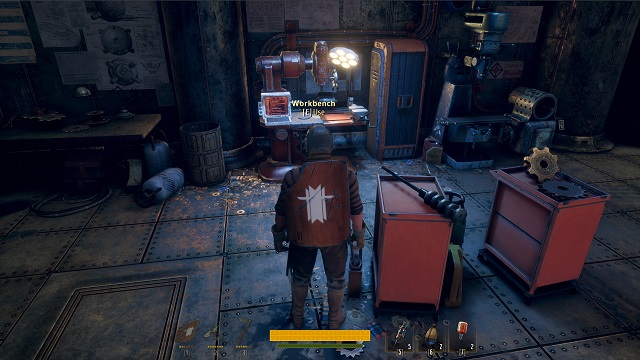
The last piece of the puzzle is crafting.
Insomnia has dozens of recipes and schematics to collect in order to craft everything from grenades and ammunition to repair parts and story items.
But again, this part is slow and plodding as well. Despite having discovered nine areas on Object 6 so far, I’ve only found two workbenches, meaning that backtracking is the headline and looting is the subtitle.
While robust in nature, the only real value I’ve found in crafting so far is in repairing my weapons. Being that I don’t have any schematics for actual armor or weapons yet (sans three for grenades I arguably don’t need), I don’t feel at all compelled to craft a blasted thing.
The components I needed to repair that one generator that one time I needed to get in that apartment were lying in a junk pile. No need to travel all that distance to craft them …
The Verdict (For Now)
Insomnia has great potential. But like some games with promise, it often finds ways to undermine itself.
From overly complex storylines to tedious gameplay elements, a curiously obtuse inventory system and an identity somewhere between sci-fi RPG and supernatural horror, it’s a game full of competing interests.
That’s not to mention the veritable grind for experience points can make you feel like character and skill progress is going nowhere fast.
However that may be, I must admit there’s something about Insomnia that keeps me coming back. Despite my critical stance on some of the game’s elements, it’s world is utterly fascinating in its construction and scope. The score is pitch-perfect and thanks to a pre-release patch, the environments are beautiful in spite of their dinginess.
Ultimately, I’ve had fun playing Insomnia: The Ark, and I plan on continuing my journey — even if it is messy. All I hope is that its disjointed beginning coalesces into something more cohesive as I move along.
You can purchase Insomnia: The Ark on Steam for $29.99.
—
[Editor’s Note: The score represented here is what we would give Insomnia: The Ark right now. This score could change as we make our way further into its diesel-punk futurescape, and after the game’s Day One patch.There are also certain gameplay elements, such as team combat, we’ve not touched on here since our time with them has been limited so far. The developer provided the copy of the game used in this review. ]

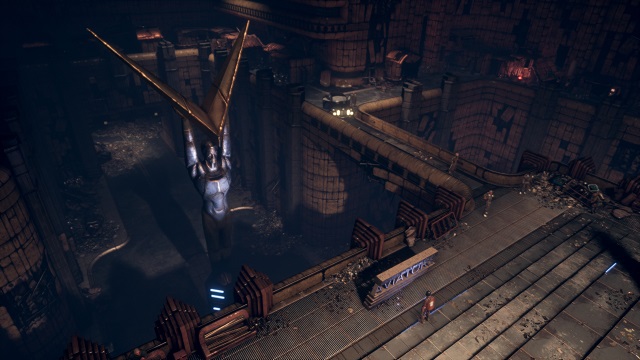





Published: Sep 27, 2018 12:41 pm